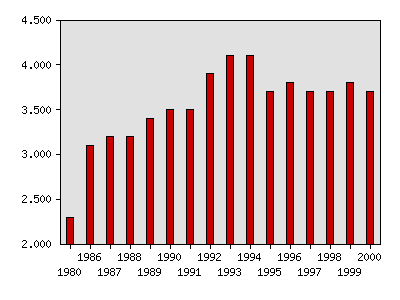What were things like in 2002?
The following idicator summary is from the 2002 Minnesota Milestones and does not neccessarily reflect the current data trends.Indicator : Timber harvest
Rationale: Not exceeding a sustainable yield of timber is important to maintain the quality of Minnesota's forests. Timber is critical to a wide range of industries in the state, from paper to tourism.
About this indicator: The timber harvest has increased substantially over the past two decades, rising from 2.3 million cords in 1980 to 3.7 million cords in 2000, an increase of 61 percent. The harvest has fluctuated some during this time period, but has been quite stable since 1995. As harvests grow, it becomes increasingly important to use methods that preserve the economic, environmental and recreational benefits of Minnesota's forests.
Timber harvest, millions of cords

| Year | Data |
|---|---|
| Timber harvest, millions of cords, Minnesota Department of Natural Resources | |
| 1980 | 2.3 |
| 1986 | 3.1 |
| 1987 | 3.2 |
| 1988 | 3.2 |
| 1989 | 3.4 |
| 1990 | 3.5 |
| 1991 | 3.5 |
| 1992 | 3.9 |
| 1993 | 4.1 |
| 1994 | 4.1 |
| 1995 | 3.7 |
| 1996 | 3.8 |
| 1997 | 3.7 |
| 1998 | 3.7 |
| 1999 | 3.8 |
| 2000 | 3.7 |
For comparison: A study conducted for the Minnesota Environmental Quality Board in 1994 estimated a maximum sustainable yield of 5.5 million cords per year from commercial forests, assuming that the harvesting is done in a way that minimizes its impact.
Things to think about: The size of the timber harvest is only one of several important factors with an impact on forest habitats. Other factors include where, how and what types of trees are harvested, as well as what types of trees are left standing. Tree stands of a single age or species do not provide as rich a habitat as mixed forest.
Forests provide such benefits as erosion and flood control, regulation of the climate, wildlife habitat, hunting and recreation. Forests also absorb and store carbon dioxide, reducing Minnesota's contribution to global climate change. Some county and state forests in Minnesota have been independently certified as being sustainably managed. Lumber coming from such forest lands is called certified. Demand for such lumber has been strongest in Europe, but has been growing in the U.S.
Technical notes: This indicator includes harvests from all Minnesota's commercial timberlands, including all types of ownership and all species of trees. The drop in the timber harvest in 1995 reflects an adjustment based on decreased use of firewood since 1989 and 1990.
Sources:Minnesota Department of Natural Resources, www.dnr.state.mn.us
Related 2002 Milestones indicator:
Other related indicators:
- Energy use by fuel type (Minnesota Department of Commerce, www.commerce.state.mn.us)
Local data:





